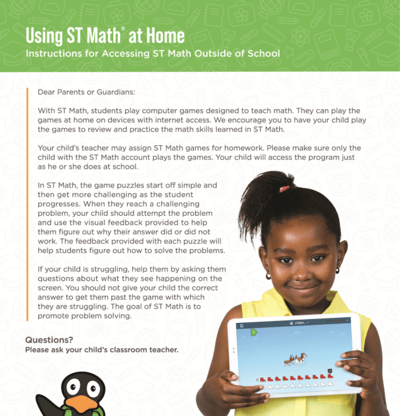
If you’re like many parents, when you hear the words “I need help with my math homework,” you’re filled with dread.
The good news is that ST Math, the game-based instructional software, is like no other math homework out there.
Instead of showing students how to solve a particular problem, parents become the facilitator by asking probing questions to guide students through their homework.
The goal of ST Math is to not only help students learn crucial math concepts by conquering tough challenges, but also gain self confidence in the process. That means it’s okay to struggle, make mistakes and get answers wrong.
Parents become the facilitators, rather than giving students the answers.
Homework is a great opportunity to teach students perseverance! Encourage your student to keep trying and guide them through their homework but never just give them the answer.
Your child’s teacher may assign ST Math games for homework or summer work. In ST Math, the game puzzles start off simple and then get more challenging as the student progresses. When they reach a challenging problem, they may ask for your help.
As a facilitator and resource, you might ask questions like:
What do you notice about the puzzle?
What can you do to get JiJi across the screen?
Describe the strategy that you are going to use.
You may need to ask these questions several times to help your child think through the math in the game. Encourage your child to take risks and ask them to explain what they learn from the wrong answer.
It’s also important that your student spend enough time on the program to make an impact, the ideal being 30 minutes each session. This will allow students to master concepts and persevere.
If you’re having difficulties at home and need a tutorial or further training on how to best facilitate ST Math at home, reach out to your student’s teacher. They have been trained on the program and are equipped with tools and resources to help.
 Download the Parent Kit for Using ST Math at Home
Download the Parent Kit for Using ST Math at Home
Reading with your child is considered an integral part of a daily or nightly routine. But shouldn't math also be equally important?
We don't mean doing worksheets of problems with your child. Instead, think about how you can incorporate mathematical conversation into daily activities like cooking, shopping, driving, or combine them with other activities like games, art and puzzles.
You can use ST Math to promote mathematical conversation with one of these ideas below:
For more ideas on how to bring math into your family's routine, check out these resources:
This blog was originally posted September 23, 2014 and has been updated with more resources for parents.

Twana is Vice President of Curriculum and Instruction at MIND Research Institute. Follow her on Twitter @TwanaYoung.
Comment